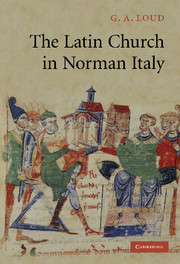Book contents
- Frontmatter
- Contents
- Preface
- List of maps
- List of abbreviations
- Map I Southern Italy: archbishoprics and principal bishoprics
- Map II Southern Italy: abbeys
- Map III The dioceses of Sicily in the late twelfth century
- Map IV The dioceses of the Terra di Bari
- Map V The dioceses of the Terra di Lavoro
- Introduction
- 1 The Church in southern Italy before the Normans
- 2 The Church and the Norman conquest
- 3 The papacy and the rulers of southern Italy
- 4 The papacy and the Church in southern Italy
- 5 The kings of Sicily and the Church
- 6 The Church and military obligation
- 7 The secular Church
- 8 Monasticism
- 9 Latins, Greeks and non-Christians
- Conclusion
- Appendices
- Bibliography
- Index
7 - The secular Church
Published online by Cambridge University Press: 04 May 2010
- Frontmatter
- Contents
- Preface
- List of maps
- List of abbreviations
- Map I Southern Italy: archbishoprics and principal bishoprics
- Map II Southern Italy: abbeys
- Map III The dioceses of Sicily in the late twelfth century
- Map IV The dioceses of the Terra di Bari
- Map V The dioceses of the Terra di Lavoro
- Introduction
- 1 The Church in southern Italy before the Normans
- 2 The Church and the Norman conquest
- 3 The papacy and the rulers of southern Italy
- 4 The papacy and the Church in southern Italy
- 5 The kings of Sicily and the Church
- 6 The Church and military obligation
- 7 The secular Church
- 8 Monasticism
- 9 Latins, Greeks and non-Christians
- Conclusion
- Appendices
- Bibliography
- Index
Summary
The discussion so far has tended to analyse the Church from above, from the viewpoint of popes and kings, or through its most important benefactors, most of whom came from the higher ranks of the aristocracy. Given the inherent bias of the sources, such concerns are inevitable, and it would be rash to downplay the importance of these influences upon the south Italian Church. However, one also needs to examine the internal structures and the personnel of the Church, and to attempt to glean (insofar as one can) something of its spiritual life and religious interaction with the laity. There was after all more to the Church than simply law, administration and patronage, significant as these undoubtedly were. How therefore did churchmen fulfil their mission to minister to the spiritual welfare of their flocks, and ultimately to save their souls, if they could?
One feature of the south Italian Church which has already been noted was the proliferation of bishoprics, and the small size of many of the resultant dioceses. Given that relatively few bishops, at least on the mainland, had a political role or would have spent much time at the royal court, and that such occasions as papal councils were infrequent, the majority of prelates are likely to have spent most of their time within their diocese, resident at their cathedrals.
- Type
- Chapter
- Information
- The Latin Church in Norman Italy , pp. 363 - 429Publisher: Cambridge University PressPrint publication year: 2007

